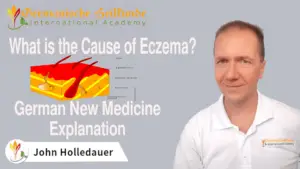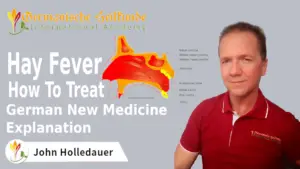
Continuously high blood pressure is the active phase of a fluid conflict.
After resolving this conflict, the blood pressure immediately lowers to normal,
but in the healing phase, the kidney cyst, Wilms’ tumor develops.
What is causing Hypertension?
In this video, we will discuss is persistent hypertension.
Persistent hypertension is the conflict-active phase of a fluid conflict concerning the kidney parenchyma. The kidney parenchyma is the glomerular tissue where the primary urine is produced. A pair of kidneys produce about 180 liters of primary urine daily, 99% of which is subsequently reabsorbed by the kidney-collecting tubules (yellow group). We pee out about 1.5 liters of urine daily.
With the kidney parenchyma, we are in the cerebral medulla-controlled orange group, in the so-called deluxe group, where the biological sense occurs only at the end of the healing phase.
Here Mother Nature helps, therefore only at the end of the healing phase! We must solve the associated conflict first; then we must survive the healing phase; only then does the biological sense come to bear, but then for a lifetime.
Fluid conflict means too much fluid. Typically, a near drowning, a flood, or a leaking roof. But it doesn’t always have to be water; that is the fluid. For example, a leaking oil tank in the garden also can cause this fluid conflict or an overturned milk tanker. Of course, to start such a sensible biological special program, always a biological conflict with its three criteria must start, highly acute-dramatic, isolativ perceived, and caught on the wrong foot!
The saying: I drown in work! is not a fluid conflict. Beginners like to psychologize. But we must learn to think biologically.
In the active phases the parenchyma of the kidney necrotizes. To still be able to excrete the urinary substances, the body increases blood pressure. Both values are increased, the systolic and diastolic values, and this continues until this fluid conflict is resolved. So this hypertensive patient has an active fluid conflict going on.
If I can resolve this fluid conflict, the blood pressure immediately normalizes. Now, however, a so-called renal cyst develops. A thin-walled cyst filled with fluid tissue protrudes from the necrosis and adheres everywhere, supplying itself with blood.
In this phase, this kidney cyst is called a malignant Wilms’ tumor in conventional medicine.
This still-fluid tissue has a high rate of cell division. The larger the conflict load, the larger this kidney cyst becomes. This still liquid cyst can possibly burst due to a fall. Then this cellular fluid flows into the abdomen and can cause adhesions. The crisis is inconspicuous like any cerebral medulla, with constriction of the blood vessels and cold extremities.
In Germanische Heilkunde, we call this kidney cyst a healing cyst because it develops in the healing phase and needs nine months to pass from the liquid to the solid phase – we also say it indurates. At the end of the healing phase, that is, after these nine months, this cyst is solid, has a tough capsule, has detached itself from the surrounding tissue, and is now only attached by a stalk to the initial kidney. This stalk has a vein, an artery, that now supplies itself with blood through this, and this stalk has a ureter. The renal cyst produces primary urine, which is the biological sense.
If this kidney cyst disturbs mechanically because of its size, it is also operated in Germanische Heilkunde. One cuts this little stalk, and with the bare hand, one can detach the compact kidney cyst from the surrounding tissue without having to cut far into the healthy tissue because these supposedly malignant infiltrations have spontaneously disappeared and are no longer present. Of course, we would not remove the fully functional kidney. What would be the point? The creeping crawling cells that are supposed to cause metastases do not exist.
You just have to wait nine months for the cyst to become solid and indurated.
If it had been a mechanical problem, of course, you would remove the cyst by surgery. We could spare the absolute nonsense by removing the fully functional kidneys and the devil’s bargain with chemo to all patients.
A patient came to Dr. Hamer with a huge belly. The doctors in Nuremberg diagnosed this patient with ascites and said his abdomen was full of metastases and he had only a few weeks more to live, so they refused to operate.
However, Dr. Hamer saw in the patient’s brain CT that he must not have ascites but a huge kidney cyst, and he took this patient to a surgeon friend of his. But this surgeon also thought the patient had ascites and did not want to operate. So the two doctors bet a box of champagne. The surgeon cut open the patient’s abdomen slapped his hands together, and yelled, “For heaven’s sake! Hamer is right! And he cut out the patient’s 45-pound kidney cyst, which was completely encapsulated.
Incidentally, the conflict with this patient was the discovery that his oil tank in the garden was defective and oil was leaking out. When the damage was repaired, he got into the healing phase.
So if you have continuously high blood pressure for a long time, you have accumulated a large load of conflict. Should one resolve this fluid conflict, the blood pressure normalizes, but now a large renal cyst develops.
It would not be a problem if we had a clinic for Germanische Heilkunde. But we don’t have one, and now this patient has to go to conventional medicine, and there is scaremongering, chemo, and morphine.
In conventional medicine, people think that high blood pressure would cause a heart attack or that blood vessels could burst. This is all complete nonsense, Dr.Hamer said.
Conventional doctors mix up the epileptic seizure of the heart myocardium with ulceration of the external and internal carotid arteries and necrosis of the kidney parenchyma. Dr. Hamer said that, in reality, the increased blood pressure is needed to remove the urinary substances and that the entire vascular system adapts to the increased blood pressure.
So: don’t believe anything; study it yourself, learn to understand it yourself, and form your own opinion.
As far as the knowledge of the cause is concerned, you then will always be one step ahead of the conventional physician.
Goodbye, until the following video.












Copyright © 2024 by GHk Online Service, LLC
| Cookie | Duration | Description |
|---|---|---|
| cookielawinfo-checkbox-analytics | 11 months | This cookie is set by GDPR Cookie Consent plugin. The cookie is used to store the user consent for the cookies in the category "Analytics". |
| cookielawinfo-checkbox-functional | 11 months | The cookie is set by GDPR cookie consent to record the user consent for the cookies in the category "Functional". |
| cookielawinfo-checkbox-necessary | 11 months | This cookie is set by GDPR Cookie Consent plugin. The cookies is used to store the user consent for the cookies in the category "Necessary". |
| cookielawinfo-checkbox-others | 11 months | This cookie is set by GDPR Cookie Consent plugin. The cookie is used to store the user consent for the cookies in the category "Other. |
| cookielawinfo-checkbox-performance | 11 months | This cookie is set by GDPR Cookie Consent plugin. The cookie is used to store the user consent for the cookies in the category "Performance". |
| viewed_cookie_policy | 11 months | The cookie is set by the GDPR Cookie Consent plugin and is used to store whether or not user has consented to the use of cookies. It does not store any personal data. |
You’ll be informed by email when we post new articles and novelties. In every email there is a link to modify or cancel your subscription.